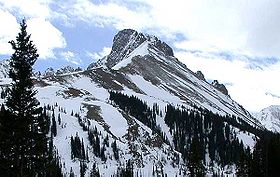Never Summer Mountains
| Never Summer Mountains | |
|---|---|

Nokhu Crags, at the northern end of the Never Summer Mountains
|
|
| Highest point | |
| Peak | Mount Richthofen |
| Elevation | 12,945 ft (3,946 m) |
| Coordinates | 40°28′10″N 105°53′42″W / 40.46944°N 105.89500°W |
| Dimensions | |
| Length | 10 mi (16 km) north-south |
| Area | 25 sq mi (65 km2) |
| Geography | |
| Country | United States |
| State | Colorado |
| County | Jackson, Grand and Larimer |
| Range coordinates | 40°25′N 105°54′W / 40.42°N 105.9°WCoordinates: 40°25′N 105°54′W / 40.42°N 105.9°W |
| Parent range | Front Range |
The Never Summer Mountains are a mountain range in the Rocky Mountains in north central Colorado in the United States consisting of seventeen named peaks. The range is located along the northwest border of Rocky Mountain National Park, forming the continental divide between the headwaters of the Colorado River in Rocky Mountain National Park to the local-east and the upper basin of the North Platte River (North Park) to the local-west; the continental divide makes a loop in these mountains. The range is small and tall, covering only 25 sq mi (65 km2) with a north-south length of 10 mi (16 km) while rising to over 12,000 ft (3,700 m) at over ten distinct peaks. The range straddles the Jackson-Grand county line for most of its length, and stretches into Jackson and Larimer county at its northern end. A panoramic view of the range is available from sections of Trail Ridge Road in Rocky Mountain National Park. One of the northernmost peaks, Nokhu Crags, is prominently visible from the west side of Cameron Pass.
The rocks of Never Summer Mountains are younger than most of the surrounding mountain ranges. They, along with the Rabbit Ears Range to the west, were formed by volcanic and intrusive processes 24-29 million years ago and consist mostly of igneous granitic formations along with preceding metamorphic formations. Most of the highest peaks in the range are granodiorite that was uplifted during the Miocene epoch. The range's highest summit, Mount Richthofen, is the remnant of an andesite volcanic plug. The Nokhu Crags in the north are mostly Pierre Shale dating from Cretaceous times. A large thrust fault underneath the Kawuneeche Valley thrust older Precambrian rocks on top of the younger Cretaceous rocks on the east side of the range. The southern peaks are Miocene-aged granite, and finally Precambrian-aged biotite gneiss and schist.
...
Wikipedia
